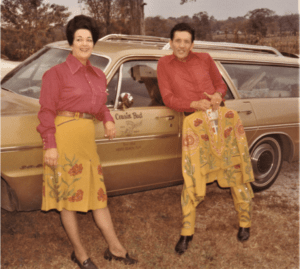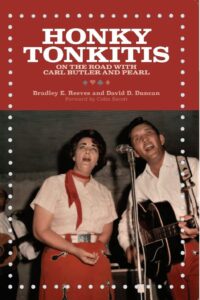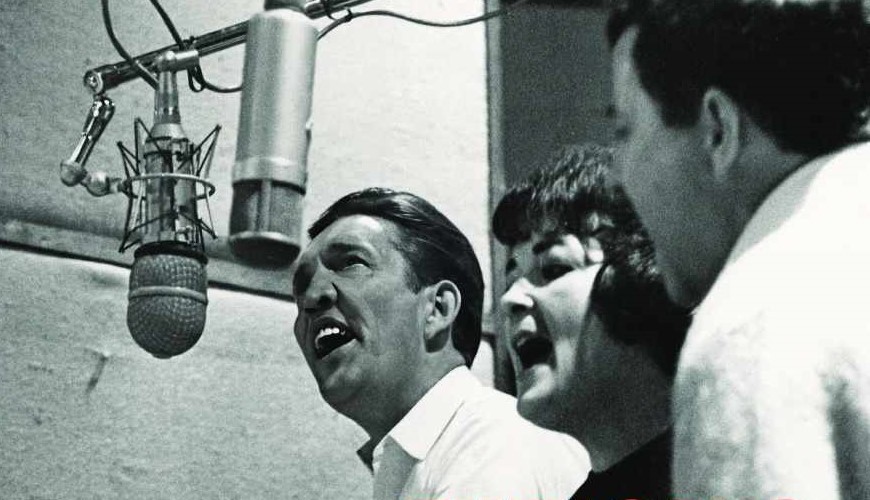Back in 2015, legendary cross-genre musician Emmy Lou Harris sat down with Dan Rather for one of his Big Interview sessions on AXS-TV. She was speaking about her general dismay at the state of most modern country music. She spoke of yearning for music that was “washed in the blood. It’s like the sound of Bill Monroe’s voice. There’s something so real and authentic about it.”
Harris rattled off some names of the country performers that first inspired her over 50 years ago, usual suspects like George Jones, Hank Williams Sr. and Merle Haggard. But without missing a beat she named Knoxville’s own Carl and Pearl Butler, who performed as Carl Butler and Pearl. Dolly Parton has said the Butlers were like second parents to her.

Pearl and Carl Butler on tour, 1971.
Carl was born in Knoxville in 1924, and grew up, unsurprisingly, as a big fan of Roy Acuff and listening to the Grand Ole Opry on the radio. Raised in Happy Holler, he started singing at local dances and what-not by the time he was 12 years old as well as learning to play guitar. He attended Knoxville’s Stair Technical High School before heading off to the military. After his World War II service, he came home and picked back up with local bluegrass bands, eventually landing a regular stint on WNOX’s Midday Merry-Go-Round. Right after the war, he met his future wife and performing partner, Pearl Dee Jones, at a dance. He and the Nashville native married in 1946.
He had his first taste of success in the early 1950s when his song If Teardrops Were Pennies became a Top 10 country hit for Carl Smith (and again two decades later for Parton and Porter Waggoner). Having started with Capitol Records, Butler eventually moved to Columbia Records and joined the Opry, having some minor chart successes for the rest of the 1950s. Things started really turning upward in 1961, when Carl made it to number 25 on the country charts with Honky Tonkitis.
Adding his dearly beloved, Pearl, to the mix in 1962 is what really changed the Butlers’ fortunes. They hit number one with Carl’s much-covered-since-then song Don’t Let Me Cross Over. They scored five more Top 25 hits throughout the 60s. Though they continued to perform on occasion, by the mid-1970s the Butlers had pretty much retired to their Crossover Acres farm near Franklin.
As usual, there is a whole lot more to the Butlers’ story, and there’s a great chance to see, hear and read more of it starting this Saturday at the East Tennessee History Museum. The new exhibit, They Sang What They Lived: The Story of Carl & Pearl Butler, will remain until August next year. Additionally, a new book about the Butlers, Honky Tonkitis, will be available for purchase.
The book was compiled and written by one of our favorite finders of things, local media archivist Bradley Reeves, and Nashville writer David D. Duncan. The book as well as the displays will feature never before seen photos from the Butler family archives as well as artifacts from their performing years.
A Tribute to Carl and Pearl is on schedule for First Friday, Oct. 6, at the museum starting at 7 p.m. Paul Brewster and Friends Band, comprised of 14-year-old mandolin prodigy Wyatt Ellis and Grand Ole Opry performers Daniel Grindstaff, Kent Blanton, Stephen Burwell and John Meador will perform. A screening of 8mm home movies shot by the Butlers (watch for an appearance by 10-year-old Parton) along with some of the Butlers’ rarest television appearances will conclude the evening.
For more information go here and to make reservations (by tomorrow) for Friday’s performance go here.
Beth Kinnane writes a history feature for KnoxTNToday.com. It’s published each Tuesday and is one of our best-read features.

